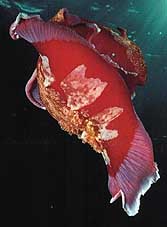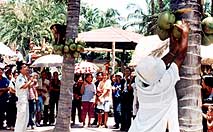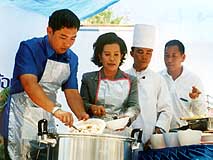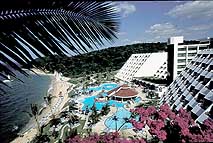





















|

Alone in an empty sea: Lord Howe Island
Born of a shield volcano which erupted seven million years
ago, Lord Howe Island lies on the edge of the chilly Tasman Sea, 370 miles off
the eastern coast of Australia. Yet this wind blown and battered remnant of an
ancient cataclysm is bathed in a clear, warm, equatorial current. It is less
steamy than the jungle islands of the South Pacific. It is, however, still
delicately tropical and is fringed by the world’s southernmost coral reef.
 A
Lord Howe Island clown fish, more conservatively dressed than its warm water
cousins A
Lord Howe Island clown fish, more conservatively dressed than its warm water
cousins
A fertile crescent, Lord Howe Island is a seven mile long
sliver of land which looms abruptly in an empty sea. Fifteen miles away, its
fraternal twin, Ball’s Pyramid, towers to a height of 1,811 feet, so sheer
it seems two dimensional to the people in boats which pass in its shadow. Part
of a chain of seamounts that formed in the South Pacific, broad islands break
the surface, built up from eruptions on the long undersea plateau, which
gradually rise to the 5,900 feet of Lord Howe Rise.
Paleontologists have found evidence that as recently as
40,000 years ago, 5 foot long armoured horned turtles roamed here. But today
the island is a gentle place with lush forests of ferns, banyon trees, and
palms. This garden, formed by the castaway spores and seeds which formed its
meadows and rain forests, is a virtual laboratory for naturalists. One third
of the island’s plants, thin howea palms, cathedral-like banyons, and
a few of its birds, are endemic; they are found nowhere else.
 A
Spanish Dancer nudibranch clings to the coral reef surrounding Lord Howe
Island A
Spanish Dancer nudibranch clings to the coral reef surrounding Lord Howe
Island
In 1834 the first settlers arrived. They were former
whalers with their Maori wives, who traded meat and vegetables to passing
ships. By 1900 the economy had turned to palm seeds for the indoor plant
industry. In 1918 when the ship Makambo ran aground, hundreds of rats rode
onto the beach with the wreckage. Their population exploded in the following
years and soon dominated the island, destroying many bird species. Only after
World War II were the rats brought under control. Today, as part of
Australia’s New South Wales, the two islands and the surrounding waters are
a world heritage site, where tourism and development are restricted.
 Lord
Howe Island Lord
Howe Island
The sea also harbours native species, for the island’s
flanks provide a self-contained environment which is isolated by distance and
temperature. As deserts have oases, oceans have islands, and naturalists have
found over 60 species of fish which were never documented before 1973. Red
polka-dot hawkfish roll in the surge of the currents, and striped morwongs lay
on the seabed in large groups, while schools of yellow butterfly fish peck at
the coral reefs. With a head like a battering ram, a Lord Howe Island
doubleheader wrasse flips over a sea urchin. Those strong teeth and the helmet
like bump on the top of its head can pulverise the underside of a sea urchin
for the eggs and meat inside. Rainbow coloured wrasses wait for scraps.
 An
island wood hen, once a prized meal for hungry sailors has been rescued from
extinction An
island wood hen, once a prized meal for hungry sailors has been rescued from
extinction
By day, schools of venomous catfish huddle together for
protection, but at night, they separate and hunt the floor of the ocean.
Spines in their fins can inflict painful wounds. A pocket of tropical life at
the edge of a colder sea, this region provides an environment for a surprising
mix of inhabitants. From the cooler water morwong, to a splendid angelfish and
the brightly speckled hawkfish, this oceanic haven in the middle of a vast sea
vibrates to the rhythm of the Pacific’s currents.
Coconut Festival held to promote the
versatile fruit
Chonburi gaining prominence as coconut source
Vichan Pladplueng
Nong Nooch Tropical Gardens in Sattahip was the venue for a
coconut festival on August 25. H.E. Sonthaya Khunpleum, the minister for
science, technology and environment opened the festivities, which were held to
demonstrate the multitude of uses of the tropical fruit.
 Man
vs. monkey - who can retrieve coconuts the quickest? Man
vs. monkey - who can retrieve coconuts the quickest?
The festival included a variety of foods prepared with
coconut, which delighted the crowd of visitors, especially foreign tourists
unfamiliar with the versatile coconut, its refreshing juice, and nutritious
flesh. An assortment of coconuts with different names and subtle differences
were also on display.
 TAT
Region 2 director Manit Boonchim (far left), Chanyut Hengtrakul (2nd left) and
H.E. Sonthaya Khunpleum (center), the minister for science, technology and
environment taste one of the many coconut dishes on offer at the Coconut
Festival. TAT
Region 2 director Manit Boonchim (far left), Chanyut Hengtrakul (2nd left) and
H.E. Sonthaya Khunpleum (center), the minister for science, technology and
environment taste one of the many coconut dishes on offer at the Coconut
Festival.
Included was a display of many sweet dishes made with
coconut juice, milk or the meat as the main ingredient, and an assortment of
the different types of coconuts grown in the region. Thai cuisine often
includes various uses of coconuts and the shoots at the top of the tree are
used as flavouring in many dishes.
 Sonthaya
Khunpleum serves up a delicious coconut recipe. Sonthaya
Khunpleum serves up a delicious coconut recipe.
A contest between men and monkeys scrambling up and down
coconut trees collecting coconuts drew laughter and cheers from the onlookers.
In Chonburi, coconut trees are cultivated on more than
124,000 rai of land. The climatic conditions in the province are highly
suitable for growing coconuts. Therefore, the agricultural promotion
department in the Ministry of Agriculture recently selected Chonburi as a
popular tourist area to help promote coconuts.
With government officials and members of the region’s
social circles having taken part in the festival’s promotion, the humble
coconut and its many uses have a promising future in exports.
The changing face of the Royal Cliff
Beach Resort
On October 1st 2001 the Royal Cliff Beach Resort is
preparing to unveil for a second time the resort property’s flagship hotel:
the all-suites Royal Wing & Spa. Originally opened in late 1986 by His
Royal Highness Crown Prince Maha Vajiralongkorn, the hotel is now in the final
stages of a renovation and improvement project worth Thai Baht 160 million
(U$$ 3.55 million). At the same time another hotel at the Royal Cliff Beach
resort - the Royal Cliff Beach Hotel - is undergoing renovations worth Thai
Baht 200 million (US$ 4.45 million). The project at the Royal Cliff Beach
Hotel, the largest of the resort’s 4 individual hotels, is also due for
completion at the end of September 2001.
 Lobby
Royal Wing Lobby
Royal Wing
The Royal Wing & Spa boasts 84 one-bedroom Royal Wing
Suites and 2 three-bedroom Presidential Suites, none of which have been left
untouched the during past few months. Every suite at the hotel has undergone a
major upgrade with all being stripped bare completely at the start of the
improvement project. New Royal Wing Suites now boast a completely redesigned
interior with larger bathrooms, luxurious amenities and state-of-the-art
in-room facilities. A special feature of the bathroom is a circular Jacuzzi
bath in addition to a walk-in shower. Each suite also has two sea view
balconies, one furnished with sun beds. The improvement work done on the Royal
Wing & Spa also encompasses the hotel’s lobby, swimming pool and
gardens. The lobby has been redecorated and the areas surrounding the
hotel’s exclusive pool have been repaved and re-landscaped.
 Royal
Wing Building Royal
Wing Building
Improvements at the 531-room Royal Cliff Beach Hotel are
primarily focused on the lobby level which has been expanded and will soon
feature a 7-storey high glass atrium-style entrance. The new interior design
of the lobby is centered around a water theme with waterfalls, statues and
murals. Work at the Royal Cliff Beach Hotel is being carried out in stages
with a new lobby bar and lounge already completed. Remaining work is being
done to the reception area, restrooms and coffee shop. Rooms on two floors of
the hotel have also been completely refurbished.
General Manager Andrew J. Wood believes that the cumulative
work being done at the Royal Cliff Beach Resort will leave the entire resort
looking brand new and well prepared to cater to the increasing number of
upmarket visitors to Pattaya. “Since 1999, the number of upgrades,
improvements and additions to the resort have been quite impressive. Brand new
facilities include PEACH (Pattaya Exhibition And Convention Hall), the Cliff
Sports & Fitness Club, the Royal Cliff School of Thai Culinary Arts, and a
wine cellar. In that time improvements have been made to Royal Cliff Terrace,
the resort’s kitchens, rooms in the Royal Cliff Grand and the resort’s
private catamaran. With the Royal Cliff Beach Resort well equipped to handle
both leisure travelers and meeting delegates, occupancy levels continue to
increase on a year-to-year basis and we expect this trend to continue well
into the future. Not only have we done a lot in and around the resort to
attract quests to say with us, but the city of Pattaya itself has seen
numerous changes and improvements in recent years that will draw both foreign
and local visitors back here.
TAT Travel Mart coming to PEACH
The Tourist Authority of Thailand (TAT) together with the
Association of Thai Travel Agents (ATTA), are preparing for the “Thailand
Travel Mart 2001”, which will take place September 16-20 at the Pattaya
Exhibition and Convention Hall (PEACH) at the Royal Cliff Beach Resort.
Manit Bunchim, director of the TAT Central Region 3 Office,
said the TAT and members of the Thai Hotel Association Eastern Chapter and the
Pattaya Hotel Community, organizers of the “Thailand Travel Mart 2001”,
have invited more than 300 tourist industry representatives from around the
world. All together more than 800 participants are expected to meet at PEACH
to discuss ways to attract more tourists to Thailand.
The Pattaya City administration, along with the TAT Central
Region 3 Office and the Pattaya Business and Tourism Association, the Thai
Hotel Association Eastern Chapter including Pattaya’s Hotel Association are
planning to host a beach buffet party on September 19 for the many businesses
and companies attending from around the world. Representatives from
Pattaya’s restaurant and entertainment businesses and the many tourist
attractions in the area are supporting the party, including Nong Nooch
Tropical Gardens, Alcazar Show, Tiffany Show, Mini Siam, Million Year Stone
Park and Crocodile Farm, Sriracha’s Tiger Zoo, World Gems Collection and the
Thai Nam Thip Water Company (Pattaya Branch).
Updated every Friday
Copyright 2001 Pattaya Mail Publishing Co.Ltd.
370/7-8 Pattaya Second Road, Pattaya City, Chonburi 20260, Thailand
Tel. 66-38 411 240-1, 413 240-1, Fax: 66-38 427 596
Updated by
Chinnaporn Sungwanlek, assisted by Boonsiri Suansuk.
E-Mail: [email protected]
|
|